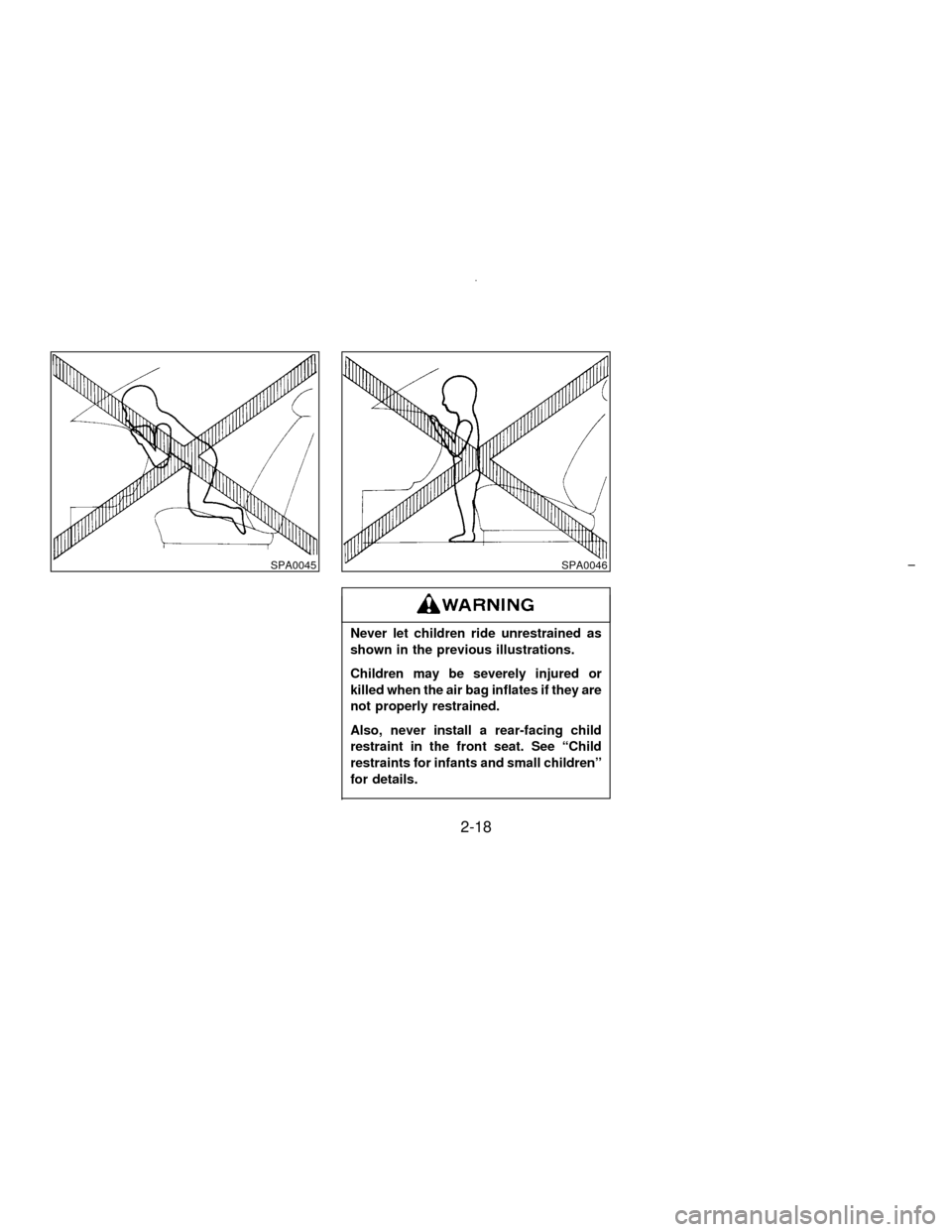1996 NISSAN MAXIMA child restraint
[x] Cancel search: child restraintPage 1 of 197

Foreword
Welcome to the growing family of new NISSAN owners. This vehicle is delivered to you with confidence. It was produced using the latest techniques
and strict quality control.
This manual was prepared to help you understand the operation and maintenance of your vehicle so that you may enjoy many miles of driving
pleasure. Please read through this manual before operating your vehicle.
A separate ªWarranty Information bookletº explains details about the warranties covering your vehicle.
Your NISSAN dealer knows your vehicle best. When you require any service or have any questions, he will be glad to assist you with the extensive
resources available to him.
IMPORTANT SAFETY INFORMATION
REMINDERS FOR SAFETY!
Follow these five important driving rules to help ensure a safe and
complete trip for you and your passengers!
INEVER drive under the influence of alcohol or drugs.
IALWAYS observe posted speed limits and never drive too fast
for conditions.
IALWAYS use your seat belts and appropriate child restraint
systems.
IALWAYS provide information about the proper use of vehicle
safety features to all occupants of the vehicle.
IALWAYS review this Owner's Manual for important safety
information.
1995 NISSAN MOTOR CO., LTD.
TOKYO, JAPAN
NOTES ON THE INFORMATION CONTAINED IN THIS
OWNER'S MANUAL
This owner's manual contains descriptions and operating instruc-
tions for all systems, features and optional equipment that might
appear in any model of this vehicle built for any destination in
North America, including the continental United States, Canada
and Hawaii. Therefore, you may very well find information in this
manual that does not apply to your vehicle.
MODIFICATION OF YOUR VEHICLE
This vehicle should not be modified. Modification could affect its
performance, safety or durability, and may even violate governmental
regulations. In addition, damage or performance problems resulting
from modification may not be covered under NISSAN warranties.
All information, specifications and illustrations in this manual are those
in effect at the time of printing. NISSAN reserves the right to change
specifications or design without notice and without obligation.
Z01.2.1/A32-DX
Page 30 of 197

2 Pre-driving checks and adjustments
Key ............................................................................ 2-2
Door locks ................................................................. 2-2
Multi-remote control system ...................................... 2-5
Hood release ............................................................. 2-8
Glove box lock .......................................................... 2-8
Trunk lid lock ............................................................. 2-9
Fuel filler lid lock ..................................................... 2-10
Seats ....................................................................... 2-12
Supplemental restraint system
(Air bag system) ...................................................... 2-17
Caution and warning labels..................................... 2-21
Air bag warning light ............................................... 2-21
Seat belts ................................................................ 2-23
Child restraints for infants and small children......... 2-29
Tilting steering wheel .............................................. 2-35
Outside mirror remote control ................................. 2-36
Foldable outside mirrors.......................................... 2-36
Inside mirror ............................................................ 2-36
Z01.2.1/A32-DX
Page 47 of 197

Never let children ride unrestrained as
shown in the previous illustrations.
Children may be severely injured or
killed when the air bag inflates if they are
not properly restrained.
Also, never install a rear-facing child
restraint in the front seat. See ªChild
restraints for infants and small childrenº
for details.
SPA0045SPA0046
2-18
Z01.2.1/A32-DX
Page 52 of 197

PRECAUTIONS ON SEAT BELT
USAGE
Your chances of being injured or killed in an
accident and/or the severity of injury may be
greatly reduced if you are wearing your seat
belt and it is properly adjusted. NISSAN
strongly encourages you and all of your pas-
sengers to buckle up every time you drive,
even if your seating position includes an air
bag.
Some states, provinces or territories re-
quire that seat belts be worn at all times
when a vehicle is being driven.
IEvery person who drives or rides in
this vehicle should use a seat belt at
all times. Children should be in ap-
propriate child restraints.
IThe belt should be adjusted properly
and to a snug fit. Failure to do so will
reduce the effectiveness of the entire
restraint system and increase the
chance or severity of injury in an
accident.
IDo not wear the belt inside out ortwisted. Be sure the seat belt tongue
is securely fastened to the proper
buckle.
IDo not allow more than one person to
use the same belt.
IAll seat belt assemblies including re-
tractors and attaching hardware
should be inspected by your NISSAN
dealer after any collision. NISSAN
recommends that all seat belt assem-
blies in use during a collision be
replaced unless the collision was mi-
nor and the belts show no damage
and continue to operate properly.
Seat belt assemblies not in use dur-
ing a collision should also be in-
spected and replaced if either dam-
age or improper operation is noted.
INever carry more people in the ve-
hicle than there are seat belts.
If the seat belt warning lamp glows con-
tinuously while the ignition is turned
ªONº with all doors closed and all seat
belts fastened, it may indicate a mal-
function in the system. Have the system
checked by your NISSAN dealer.Be sure to observe the following cau-
tions when using seat belts. Failure to
do so could increase the chance and/or
severity of injury in an accident.
IAlways route the shoulder belt over
your shoulder and across your chest.
Never run the belt under your arm or
across your neck. The belt should be
away from your face and neck, but
not falling off your shoulder.
IPosition the lap belt as low as pos-
sible AROUND THE HIPS, NOT THE
WAIST.
ISerious injury or death can occur if
the seat belt is not worn properly.
CHILD SAFETY
Children need adults to help protect them.
All U.S. states and provinces of Canada re-
quire the use of approved child restraints for
infants and small children. (See ªChild re-
straints for infants and small childrenº later in
this section.)
In addition, there are many types of child
restraints available for larger children which
should be used for maximum protection.
SEAT BELTS
2-23
Z01.2.1/A32-DX
Page 53 of 197

Infant or small child
NISSAN recommends that infants or small
children be placed in child restraint systems
that comply with Federal Motor Vehicle Safety
Standards or Canadian Motor Vehicle Safety
Standards. You should choose a child restraint
system that fits your vehicle and always follow
the manufacturer's instructions for installation
and use.
Children
Children who are too large for child restraint
systems should be seated and restrained by
the seat belts which are provided.
NISSAN recommends that children sit in the
rear seat if possible. According to accident
statistics, children are safer when properly
restrained in the rear seat than in the front
seat.
If the child's seating position has a shoulder
belt that fits close to the face or neck, the use
of a booster seat (commercially available) may
help overcome this. The booster seat should
raise the child so that the shoulder belt is
properly positioned across the top, middle
portion of the shoulder and the lap belt is low
on the hips. The booster seat should fit the
vehicle seat and have a label certifying that it
complies with Federal Motor Vehicle SafetyStandards or Canadian Motor Vehicle Safety
Standards. Once the child has grown so the
shoulder belt is no longer on or near the face
and neck, use the shoulder belt without the
booster seat.
Never let a child stand or kneel on any seat
and do not allow a child in the cargo areas
while the vehicle is moving.
Pregnant women
NISSAN recommends that pregnant women
use seat belts. Contact your doctor for specific
recommendations. The lap belt should be
worn snug and positioned as low as possible
around the hips, not the waist.
Injured persons
NISSAN recommends that injured persons
use seat belts, depending on the injury. Check
with your doctor for specific recommendations.
2-24
Z01.2.1/A32-DX
Page 55 of 197

3-point seat belts have a cinching mechanism
for child seat installation. It is referred to as the
automatic locking mode.
When the cinching mechanism is activated the
seat belt cannot be withdrawn again until the
seat belt tongue is detached from the buckle
and fully retracted. Refer to ªChild restraints for
infants and small childrenº later in this section
for more information.
IThe automatic locking mode should
be used only for child seat installa-
tion. During normal seat belt use by a
passenger, the locking mode should
not be activated. If it is activated it
may cause uncomfortable seat belt
tension.
Unfastening the belts
To unfasten the belt, press the button on the
buckle. The seat belt will automatically retract.
Checking seat belt operation
(3-point type with retractor)
Your seat belt retractors are designed to lock
belt movement using two separate methods:
1) When the belt is pulled quickly from the
retractor.
2) When the vehicle slows down rapidly.
You can check their operation as follows:
IGrasp the shoulder belt and pull quickly
forward. The retractor should lock and re-
strict further belt movement.
If the retractor does not lock during this check
or if you have any questions about belt opera-
tion, see your NISSAN dealer.
Shoulder belt height adjustment
(For front seats)
The shoulder belt anchor height should be
adjusted to the position best for you. (See
ªPrecautions on seat belt usageº.) To adjust,
push the release button, and then move it to
the desired position, so that the belt passes
over the center of the shoulder. The belt
should be away from your face and neck, but
not falling off of your shoulder.
PD1321
2-26
Z01.2.1/A32-DX
Page 58 of 197

SEAT BELT MAINTENANCE
ITo clean the belt webbings,apply a mild
soap solution or any solution recommended
for cleaning upholstery or carpets. Then
brush the webbing, wipe it with a cloth and
allow it to dry in the shade. Do not allow the
belts to retract until they are completely dry.
IPeriodically check to see that the belt
and the metal componentssuch as buck-
les, tongues, retractors, flexible wires and
anchors work properly. If loose parts, dete-
rioration, cuts or other damage on the web-
bing is found, the entire belt assembly
should be replaced.Infants and small children should al-
ways be placed in an appropriate child
restraint while riding in the vehicle. Fail-
ure to use a child restraint can result in
serious injury or death.
Children and infants should never be
carried on your lap. It is not possible for
even the strongest adult to resist the
forces of a severe accident. The child
could be crushed between the adult and
parts of the vehicle. Also, do not put the
same seat belt around both your child
and yourself. In general, child restraints
are designed to be installed with a lap
belt or the lap portion of a three-point
type seat belt.
Nissan recommends that the child re-
straint be installed in the rear seat. Ac-
cording to accident statistics, children
are safer when properly restrained in the
rear seat than in the front seat.
An improperly installed child restraint
could lead to serious injury or death in
an accident.
Child restraints specially designed for infants
and small children are offered by several
manufacturers. When selecting any child re-
straint, keep the following points in mind:
1) Choose only a restraint with a label certify-
ing that it complies with Federal Motor
Vehicle Safety Standard 213 or Canadian
Motor Vehicle Safety Standard 213.
2) Place your child in the child restraint and
check the various adjustments to be sure
the child restraint is compatible with your
child. Always follow all recommended pro-
cedures.
3) Check the child restraint in your vehicle to
be sure it is compatible with the vehicle's
seat belt system.
INever install a rear-facing child re-
straint in the front seat. A rear-facing
child restraint must only be used in
the rear seat. See ªInstallation on
front passenger seatº for details.
IFollow all of the child restraint manu-
facturer's instructions for installation
and use. When purchasing a child
restraint, be sure to select one which
will fit your child and vehicle. It may
CHILD RESTRAINTS FOR
INFANTS AND SMALL CHILDREN
2-29
Z01.2.1/A32-DX
Page 59 of 197

not be possible to properly install
some types of child restraints in your
vehicle.
Improper use of a child restraint can
result in increased injuries for both
the infant or child and other occu-
pants in the vehicle.
IWhen your child restraint is not in
use, store it in the trunk or keep it
secured with a seat belt to prevent it
from being thrown forward in case of
a sudden stop or accident.
IAfter attaching a child restraint, test
the restraint before you place the
child in it. Tilt it from side to side. Try
to tug it forward and check to see if
the belt holds it in place. If the re-
straint is not secure, tighten the belt
as necessary, or put the restraint in
another seat and test it again.
IIf the child restraint is not anchored
properly, the risk of a child being
injured in a collision or a sudden stop
greatly increases.
IAdjustable seatbacks should be posi-
tioned to fit the child restraint, but asupright as possible.
IRemember that a child restraint left in
a closed vehicle can become very
hot. Check the seating surface and
buckles before placing your child in
the child restraint.
IAll U.S. states and provinces of
Canada require that infants and small
children be restrained in approved
child restraints at all times while the
vehicle is being operated.
IFor a front facing child restraint, if the
seat position where it is installed has
a 3-point type lap/shoulder belt,
check to make sure the shoulder belt
does not go in front of the child's face
or neck. If it does, put the shoulder
belt behind the child restraint.
Installation on rear seat
Center lap belt
Secure the child restraint with the lap belt as
illustrated. Remove all slack in the lap belt for
a very tight fit by pulling forcefully on the lap
belt adjustment.
After attaching the child restraint, test it before
you place the child in it. Tilt the restraint from
side to side. If it is not secure, try to tighten the
belt again, or put the restraint in another seat.
SPA0276
2-30
Z01.2.1/A32-DX